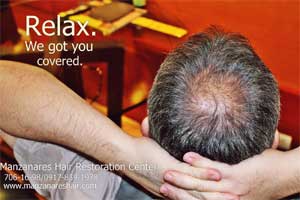 Baldness involves the state of lacking hair where it often grows, especially on the head. The most common form of baldness is a progressive hair thinning condition called androgenetic alopecia or 'male pattern baldness' that occurs in male and female. In men, genetic hair loss, also called male pattern baldness (MPB), is responsible for more than 95% of all hair loss. Androgenetic alopecia is a slow process in which follicles that is producing terminal hairs change. They begin to produce thinner, more brittle, shorter hairs with weaker shafts. Eventually, these follicles produce only fine, almost invisible, short hairs, or they may die out completely. It is important to understand the possible causes of male and female hair loss so that you can make an intelligent and informed decision about how to treat it. Certain hair loss treatments are more appropriate for certain hair loss causes while others have no effect at all.
Baldness involves the state of lacking hair where it often grows, especially on the head. The most common form of baldness is a progressive hair thinning condition called androgenetic alopecia or 'male pattern baldness' that occurs in male and female. In men, genetic hair loss, also called male pattern baldness (MPB), is responsible for more than 95% of all hair loss. Androgenetic alopecia is a slow process in which follicles that is producing terminal hairs change. They begin to produce thinner, more brittle, shorter hairs with weaker shafts. Eventually, these follicles produce only fine, almost invisible, short hairs, or they may die out completely. It is important to understand the possible causes of male and female hair loss so that you can make an intelligent and informed decision about how to treat it. Certain hair loss treatments are more appropriate for certain hair loss causes while others have no effect at all.
The Hair Growth Cycle
To understand hair loss more thoroughly, we need to look at the hair cycle. Hair usually cycles through different phases during its lifetime (anagen, catagen and telogen) and it is normal for an individual to lose approximately 150 hairs everyday because of the normal hair cycle. However, these fallen hairs will then re-grow several months later.
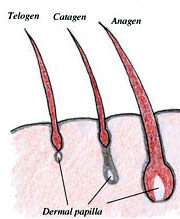
- Anagen Phase: This is the growing phase of the cycle and can lasts from three to six years. The hairs in this phase make up about 90% of the hairs on the scalp.
- Catagen Phase: This is considered the breakdown phase and can lasts a few weeks.
- Telogen Phase: This is the dormant or resting phase. The follicle continues to shrink during this phase. This phase could last many weeks.
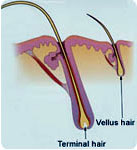 This hair cycle is normal and can account for up to 150 hairs falling everyday that are replaced by the new anagen hairs. So the number of hairs on the scalp will stay the same in a person not experiencing hairloss. The duration of each of those cycles varies from the terminal hairs when compared to the vellus hairs. Terminal hairs are defined as strong, mature and fully developed hairs. Vellus hairs are smaller miniaturized hairs that don’t grow longer than a few centimeters and are less pigmented.
This hair cycle is normal and can account for up to 150 hairs falling everyday that are replaced by the new anagen hairs. So the number of hairs on the scalp will stay the same in a person not experiencing hairloss. The duration of each of those cycles varies from the terminal hairs when compared to the vellus hairs. Terminal hairs are defined as strong, mature and fully developed hairs. Vellus hairs are smaller miniaturized hairs that don’t grow longer than a few centimeters and are less pigmented.
Factors Relating to Hair Loss
Androgenetic hair loss ("genetic programming" hair loss) which accounts for 95% of male hair loss is related to three interdependent factors namely: (1) Genes, (2) Hormones, and (3) Age.
Factor #1: Genes – It’s your "natural programming" to become bald.
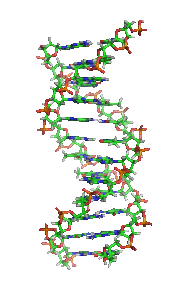 Hair loss, like eye color, is an inherited trait. A gene is a unit of heredity in living organisms, typically encoded in a sequence of nucleotide monomers that make up a long strand of DNA, or deoxyribonucleic acid. Chromosomes occur in pairs (humans have 23 pairs), and every individual gets one set of chromosomes from each parent. Genes that are located on the X or Y-chromosomes are called sex-linked. Genes on the other 22 pairs of chromosomes are called autosomal. The genes governing common baldness are autosomal.
Hair loss, like eye color, is an inherited trait. A gene is a unit of heredity in living organisms, typically encoded in a sequence of nucleotide monomers that make up a long strand of DNA, or deoxyribonucleic acid. Chromosomes occur in pairs (humans have 23 pairs), and every individual gets one set of chromosomes from each parent. Genes that are located on the X or Y-chromosomes are called sex-linked. Genes on the other 22 pairs of chromosomes are called autosomal. The genes governing common baldness are autosomal.
This means that the baldness trait can be inherited from the mother's side of the family or the father's side and not only to the mother’s side which is a myth. The genes involved in androgenetic alopecia are felt to be dominant which means that only one gene of a pair is needed for the trait (hair loss) to show up in the individual.
Factor #2: Hormones – DHT is the culprit! 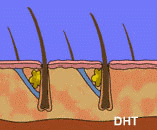 A hormone (from Greek όρμή - "to set in motion") is a chemical messenger from one cell (or group of cells) to another. The function of hormones is to serve as a signal to the target cells. The action of hormones is determined by the pattern of secretion and the signal transduction of the receiving tissue. These same hormones that cause acne and beard growth can also signal the beginning of baldness. The presence of androgens, testosterone, and its related hormone DHT (dihydrotestosterone), cause some follicles to regress and die. The hormone that is directly involved in androgenetic alopecia is actually dihydrotestosterone (DHT) rather than testosterone. DHT is a derivative of the normally present testosterone. The enzyme, type II 5-alpha-reductase, interacts with testosterone to produce DHT. Among other effects, DHT decreases the length of the anagen (growing) cycle and increases the telogen (resting) phase so that with each new cycle the hair shaft becomes progressively smaller. In some people, their follicles on the top of the head are genetically vulnerable to baldness. Over time, these genetically vulnerable follicles are acted upon by the hormone DHT.
A hormone (from Greek όρμή - "to set in motion") is a chemical messenger from one cell (or group of cells) to another. The function of hormones is to serve as a signal to the target cells. The action of hormones is determined by the pattern of secretion and the signal transduction of the receiving tissue. These same hormones that cause acne and beard growth can also signal the beginning of baldness. The presence of androgens, testosterone, and its related hormone DHT (dihydrotestosterone), cause some follicles to regress and die. The hormone that is directly involved in androgenetic alopecia is actually dihydrotestosterone (DHT) rather than testosterone. DHT is a derivative of the normally present testosterone. The enzyme, type II 5-alpha-reductase, interacts with testosterone to produce DHT. Among other effects, DHT decreases the length of the anagen (growing) cycle and increases the telogen (resting) phase so that with each new cycle the hair shaft becomes progressively smaller. In some people, their follicles on the top of the head are genetically vulnerable to baldness. Over time, these genetically vulnerable follicles are acted upon by the hormone DHT.
Hair loss occurs when DHT binds to the receptor sites on the scalp and hair follicles. The hairs that are genetically predisposed to DHT are affected by receiving signals that interrupt the normal hair growth cycle. Please understand that DHT is not the cause of hair loss. If it were, just about everybody would be bald. Instead, DHT is the hormone responsible for the loss of hairs genetically programmed to be influenced by it.
Factor #3: Age – Admit it, your age counts!
Even after a person has reached puberty, susceptible hair follicles must continually be exposed to the hormone over a period of time for hair loss to occur. Hair loss does not occur all at once or in a steady, straight-line progression. Men and women don't go bald overnight. It is a slow progression of thinning hair and hair loss that eventually produces baldness. Hair loss is definitely cyclical.
Other Causes of Hair Loss
- Telogen Effluvium
Telogen effluvium is a condition characterized by a generalized, diffuse hair loss that occurs 2 to 3 months after a significant stress on the body such as major surgery, severe illness, or even crash dieting. Any severe shock to the system can cause more than 20% of our hair follicles to enter into the resting phase (telogen) of the hair cycle. As a result, more hairs are shed than usual which leads to significant thinning of hair. The good news is that, in most cases, these hairs will return to their growing phase within a few months but it will take longer for the thin areas to fill in.
- Traction Alopecia
Certain hairstyles can contribute to hair loss, most notably styles involving tight braids or pull-backs. This form of hair loss is called traction alopecia. This occurs when the hair is pulled tightly back and fastened at the base of the skull, or braided into tight braids or rows. Exposure to this type of hairstyle over long periods can result in a scarring alopecia, with no potential for regrowth.
- Anemia
Iron deficiency (anemia) as well as thyroid disease (either an underactive or overactive thyroid) can result in hair loss. Your doctor may order specific laboratory tests to check for these conditions. Hair loss that is associated with either anemia or thyroid disease is reversible with proper treatment.
- Medication
An annoying side effect of certain medications may be temporary hair loss in a small percentage of patients. Examples of the more common drugs known to have this effect include certain blood pressure medications (beta blockers such as Inderal®), blood thinners (warfarin and heparin), as well as some of the medications used to treat gout, arthritis, and heart problems. Also, high doses of vitamin A may also cause hair loss which is reversible.
- Chemotherapy
Many agents used to treat cancer will cause hair cells to stop dividing, stopping hair growth. Up to 90% of the hairs may fall out 1 to 3 weeks after cancer treatment. Fortunately, the hair does regrow in most cases when the treatment is completed. Cancer patients should be warned of this side effect so that they have the opportunity to prepare for any possible hair loss, such as getting a wig or hairpiece, if desired, prior to treatment.
- Tinea Capitis
Tinea capitis, or ringworm, is a fungal skin infection that can cause a patchy form of hair loss when the scalp is infected. A ringworm scalp infection results in hairs breaking off at the surface of the scalp. There may be redness, flaking, scaling, swelling, and even oozing at the affected areas on the scalp. And there is often itching and pain as well. Severe cases of ringworm may lead to swollen glands in the neck or back of the head.
- Dandruff
Dandruff plays a hand in hair loss. It's caused by a fungus, malazzesia globosa, that floats around in the air. With bad cases of dandruff, the scalp becomes itchy. It takes only 90 minutes of continuous scratching to completely remove the cuticular scale—the covering on each hair the keeps them protected. Unprotected, hair shafts are permanently damaged and weak, making them more likely to fall out, hence, a hair loss.
If your hair is shedding in large amounts after brushing or combing, or if you notice that your hair is thinning, Manzanares Hair Restoration Center is here to help. If you are experiencing hair loss, it is very important that you find out the cause. Although usually genetic in nature, certain forms of hair loss may signal a disease process. Also, the treatment best for you will vary, depending on the cause of your hair loss as will be carefully examined by Dr. Manzanares.
![]()
Hair loss questions? Interested in our services? Need more info? Arrange a FREE Online Private Consultation or Visit Us at Our Hair Restoration Center!

